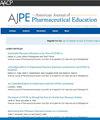Association of Cocurricular Activities to ACPE Standard #3 Elements by Student-Reported Competencies
IF 3.5
4区 教育学
Q1 EDUCATION, SCIENTIFIC DISCIPLINES
引用次数: 0
Abstract
Objective
To assess the influence of required cocurricular activities on Accreditation Council of Pharmacy Education (ACPE) Standards 2016: Standard #3 Elements-Approach to Practice and Care competencies using year-end student surveys.
Methods
Year-end surveys of first year pharmacy (P1) to fourth pharmacy year (P4) students compared student self-assessments of their aptitude for each Center for the Advancement of Pharmacy Education 2013 outcomes in ACPE Standard #3 from a 3 year period when cocurricular activities were voluntary (volunteer period) and a 3 year period when a unique cocurricular activity was required each semester without academic credit (required period). A total of 294 unique cocurricular activities were offered during the required period. t tests and analysis of variance were used to compare responses across periods within each pharmacy year and academic year.
Results
During the volunteer period, 589 student survey responses were collected (81.7% response rate), compared to 433 (79.7%) engaging in cocurricular activities (required period). The mean age of the students in both periods was 24.1 years (SD 4.3), 61.0% were female, and 49.2% had prior degrees. Students participated in 283 distinct cocurricular activities. Student self-assessment across all Standard #3 elements improved each year. The aggregate improvement range across P1 to P4 years was 25.1% to 74.4% (p <.05 for each element). The most significant improvement was observed in Domain 3.1, Problem-Solving. The greatest increase occurred during the P1 year, followed by a leveling off across the third year pharmacy to P4 years.
Conclusion
Student-reported assessment indicates that providing required cocurricular opportunities across all professional years positively influences student perceptions of competency in ACPE Standard #3 Approach to Practice and Care Elements.
根据学生报告的能力,将课外活动与ACPE标准#3要素相结合。
目的:通过年终学生调查,评估必要的课外活动对药学教育认证委员会(ACPE)标准2016:标准#3要素-实践和护理能力方法的影响。方法:对P1-P4学生进行年终调查,比较学生对ACPE标准#3中每个药学教育进步(CAPE) 2013年结果的自我评估,其中三年的课外活动是自愿的(志愿者期),而三年的课外活动是每个学期都需要的,没有学分(必修期)。在规定期间共举办了294项独特的课外活动。学生的t检验和方差分析(ANOVA)比较了每个药学年度和整个学年的不同时期的反应。结果:在义工期间,共收集了589名学生的调查回应(回复率为81.7%),而参与课外活动的学生则为433名(79.7%)。志愿者和所需时期队列的平均年龄为24.1岁(标准差:4.3),61.0%为女性,49.2%具有先前的学位。学生们参加了283项不同的课外活动。学生自我评估的所有标准#3元素每年都在提高。P1-P4年级的总体改善幅度为25.1-74.4%(结论:学生报告的评估显示,在所有专业年提供所需的课外机会对学生对ACPE标准#3实践和护理要素方法的能力感知有积极影响。
本文章由计算机程序翻译,如有差异,请以英文原文为准。
求助全文
约1分钟内获得全文
求助全文
来源期刊
CiteScore
4.30
自引率
15.20%
发文量
114
期刊介绍:
The Journal accepts unsolicited manuscripts that have not been published and are not under consideration for publication elsewhere. The Journal only considers material related to pharmaceutical education for publication. Authors must prepare manuscripts to conform to the Journal style (Author Instructions). All manuscripts are subject to peer review and approval by the editor prior to acceptance for publication. Reviewers are assigned by the editor with the advice of the editorial board as needed. Manuscripts are submitted and processed online (Submit a Manuscript) using Editorial Manager, an online manuscript tracking system that facilitates communication between the editorial office, editor, associate editors, reviewers, and authors.
After a manuscript is accepted, it is scheduled for publication in an upcoming issue of the Journal. All manuscripts are formatted and copyedited, and returned to the author for review and approval of the changes. Approximately 2 weeks prior to publication, the author receives an electronic proof of the article for final review and approval. Authors are not assessed page charges for publication.

 求助内容:
求助内容: 应助结果提醒方式:
应助结果提醒方式:


